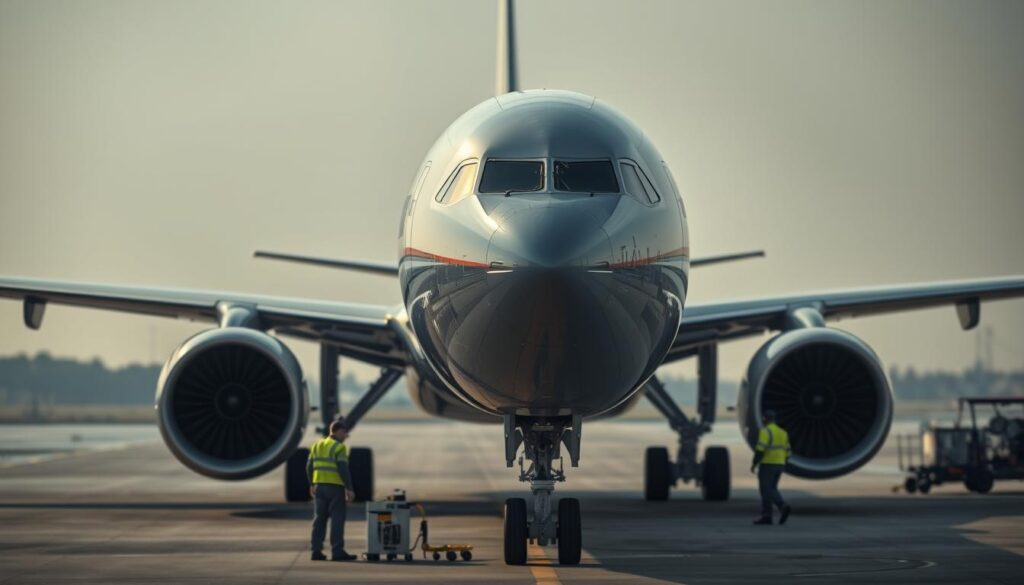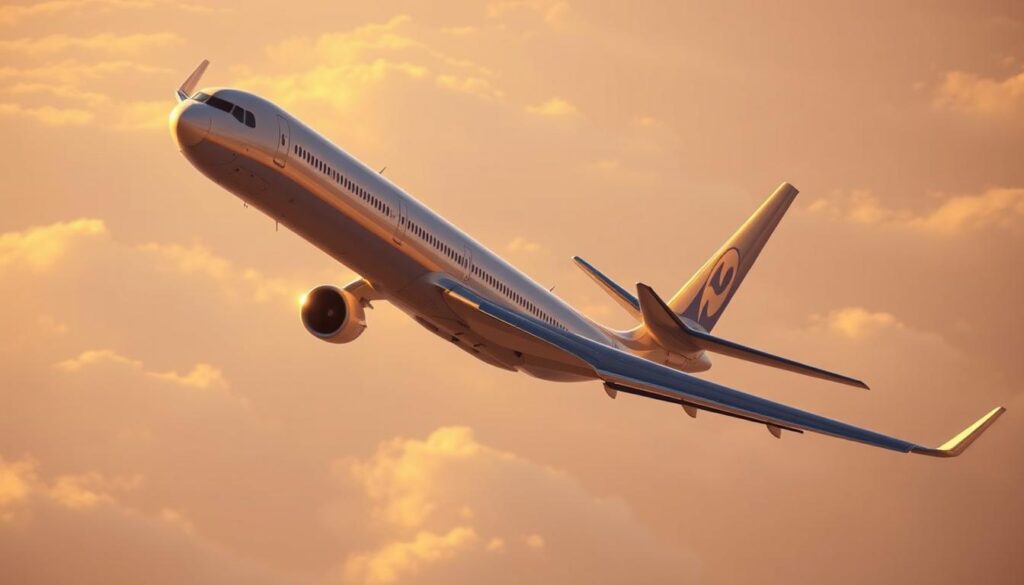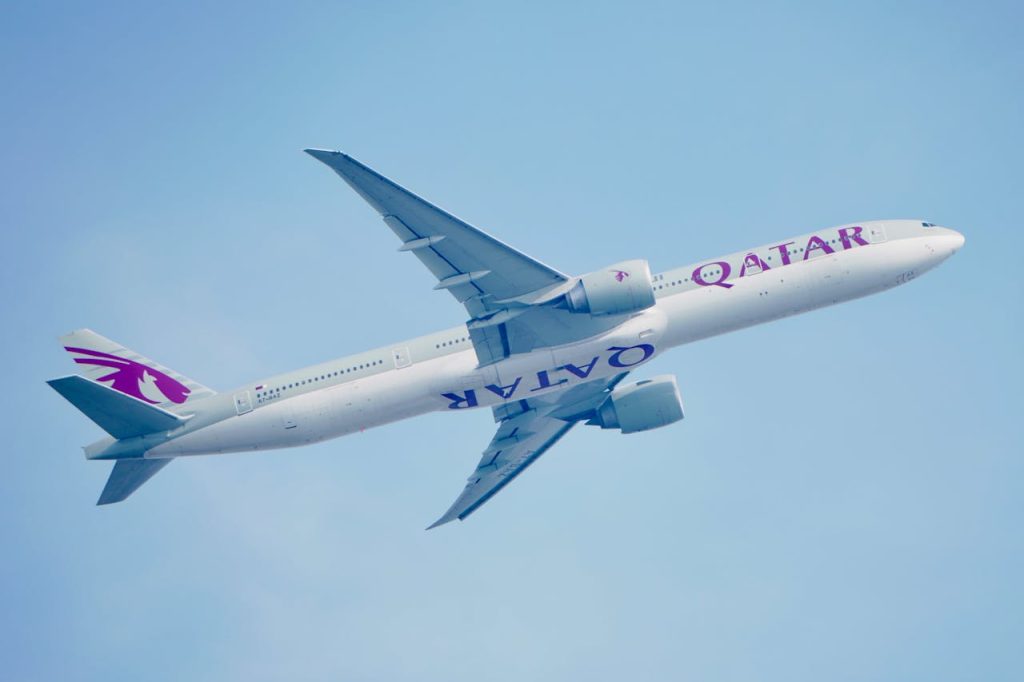Did you know the Boeing 757-300 can seat over 240 passengers? This fact shows how the 757-300 plane meets airline and passenger needs well. Looking at the Boeing 757-300, we’ll see its cool features, great performance, and its lasting impact on flying.
With strong engines and a big cabin, the Boeing 757 mixes tech with comfort. This twin-engine jet is loved by airlines and passengers for making travel easier on many routes. Let’s explore the Boeing 757-300’s performance and see why it stands out in the world of planes.
Key Takeaways
- The Boeing 757-300 can accommodate up to 240 passengers, showcasing its capacity for hefty routes.
- This aircraft is known for its long-range capabilities, making it ideal for transcontinental flights.
- With advanced technology and design, the Boeing 757 features both efficiency and comfort.
- Airlines appreciate the reliability and flexibility of the Boeing 757-300 in various operational contexts.
- The aircraft has maintained its popularity despite the emergence of newer models in the aviation sector.
Introduction to the Boeing 757-300
The Boeing 757-300 is a big deal in the 757 family with its long body and lots of seats. It shines because it can carry more people but still performs well. Made for short to mid-length trips, this plane is efficient and goes far, making it a top pick globally.
This plane takes what the Boeing 757-200 started and adds even more room for people. This is great for airlines wanting to fly more passengers without losing efficiency. It can be set up in different ways, letting airlines meet the needs of their travelers.
The Boeing 757-300 is known for taking people to many places reliably and strongly. Looking into this plane shows us how its design meets today’s flying needs.
Key Features of the Boeing 757-300
The Boeing 757-300 shines because of its powerful performance and big capacity. It combines unique features that many airlines love for long flights.
Engine Specifications and Performance
The engine specs of the Boeing 757-300 are impressive. It has two Rolls-Royce RB211-535E4B turbofan engines. These engines give a strong thrust of 191.7 kN (about 43,095.1 lbf). They help the plane take off smoothly and fly far without using too much fuel.
Innovative Design Elements
The Boeing 757-300 has a longer body by 7.11m compared to the 757-200. This change means more people can fit inside without losing speed. It has special wings that save fuel and cut down on costs. This shows smart design can make a plane perform better.
To learn more about the Boeing 757-300 features, check out its specs and design innovations. This plane is a great example of modern aviation’s progress, offering both strength and efficiency for today’s airlines.
| Feature | Specification |
|---|---|
| Engine Type | Rolls-Royce RB211-535E4B |
| Thrust | 191.7 kN (43,095.1 lbf) |
| Length | 54.47 m |
| Wingspan | 38.05 m |
| Passenger Capacity | 243 (two-class); 279 (high-density) |
Boeing 757-300 Technical Specifications
The Boeing 757-300 is known for its impressive tech specs. These details are key to its success and performance in the air travel industry. We’ll look into the Boeing 757-300 dimensions along with its range and how well it performs.
Dimensions and Capacity
The Boeing 757-300 is long, at 242 feet, and has a wingspan of 124 feet and 10 inches. Thanks to its size, it can hold up to 280 people in one class. Its big cabin makes sure passengers are comfortable, meeting different needs.
Range and Performance Capabilities
The Boeing 757’s range is impressive, reaching up to 6,500 kilometers. This makes the Boeing 757-300 ready for long flights across continents. It flies at a speed of about 500 knots. This lets airlines use it on many routes efficiently.
Boeing 757-300 Performance Analysis
The Boeing 757-300 is known for its impressive performance. It caters to both airlines and passengers. Its takeoff and landing abilities, fuel efficiency, and comfort make it a top choice in commercial aviation.
Takeoff and Landing Characteristics
The Boeing 757-300 is great at taking off and landing. Its powerful engines and advanced wings help it use shorter runways. This makes it flexible and allows it to fly to airports with limited space. Airlines like it because it opens up more route options.
Fuel Efficiency and Operational Costs
The Boeing 757-300 is very fuel-efficient. This helps airlines save money, making it an economical choice. It strikes a perfect balance between performing well and saving fuel. This lets airlines offer affordable services while still being reliable.
Passenger Comfort and Cabin Features
The cabin of the Boeing 757-300 is designed with passenger comfort in mind. With wide aisles, big overhead bins, and comfy seats, it ensures a pleasant journey. These features make it a favorite among people who fly often.
Comparative Performance with Other Aircraft
The Boeing 757-300 shines among other airplanes because of its strong performance. When we compare it to other planes, it’s clear it does better in how far it can fly, how many people it can carry, and how efficiently it operates. This makes it a go-to plane for airlines that have lots of flights. Next, we’ll see how the Boeing 757-300 measures up to its competition and which airlines prefer to use it.
Performance Metrics Against Competitors
In our comparison, the Boeing 757-300 shows it’s ahead in important areas, especially next to the Airbus A321XLR. Here’s how they stack up on key metrics:
| Aircraft Model | Maximum Range (miles) | Passenger Capacity (Economy) | Max Takeoff Weight (lbs) | Fuel Efficiency (MPG) |
|---|---|---|---|---|
| Boeing 757-300 | 6,287 | 280 | 280,000 | 3.4 |
| Airbus A321XLR | 4,700 | 244 | 200,000 | 2.8 |
Popular Routes and Airline Operators
The Boeing 757-300 is a top pick for many big airlines because it can do so much. It’s perfect for long flights across the ocean, thanks to its ability to fly far and carry lots of passengers. Some of the top airlines that fly the Boeing 757 are:
- Delta Air Lines
- American Airlines
- United Airlines
- Condor
Maintenance and Safety Features of the Boeing 757-300
Maintenance and safety play a huge role in keeping the Boeing 757-300 ready for the skies. The plane follows detailed maintenance rules. This makes sure it’s safe for everyone on board. It goes through regular checks and follows updates on safety closely, stopping issues before they start.
Aviation Safety Protocols
The Boeing 757 is packed with features to protect both crew and passengers. One important part is the over-wing exits for quick escapes in emergencies. Keeping these safety tools in top shape is crucial. Pilots also get special training to be ready for any situation. This helps them know what to do when faced with emergencies.
Scheduled Maintenance Practices
Keeping the Boeing 757-300 in good condition needs a schedule. It includes checks on the plane’s structure, how well it performs, and if safety gear is ready. Following these maintenance plans means the plane works right and meets safety rules. It’s key to look at past issues linked to maintenance, to keep improving. For more depth, check out this report on Boeing 757-300 safety, including advice from the National Transportation Safety Board.

| Maintenance Activity | Frequency | Purpose |
|---|---|---|
| Pre-flight Inspection | Every flight | Ensure operational readiness |
| Daily Checks | Daily | Monitor systems and surface conditions |
| Monthly Maintenance | Monthly | Thorough inspection of critical systems |
| Annual Overhaul | Yearly | Comprehensive assessment and replacement as needed |
Boeing 757-300 Seating Configuration
The Boeing 757-300 provides flexible cabin designs. This makes it a popular pick for different airlines. Airlines can customize their seating setups to meet their customers’ needs. With options ranging from high-density seating for shorter trips to more spacious layouts for longer flights, this versatility is a key feature.
Passenger Cabin Layout Options
Airlines have the freedom to design their Boeing 757-300 cabins to fit what passengers want. Possible choices include:
- High-density seating for budget travelers, packing in more people.
- Spacious seats for a more comfortable journey with full-service carriers.
- A mix of both, appealing to a wide range of passengers.
Legroom and Amenities
Compared to others, the Boeing 757-300 often offers more legroom. This makes for a more comfortable flight, especially on longer trips. Passengers can enjoy features like:
- Adjustable headrests for better comfort.
- In-flight entertainment to keep you occupied.
- Different meal choices, depending on the airline.
Historical Significance of the Boeing 757-300
The Boeing 757-300 has reshaped commercial aviation since its introduction. It marked a huge step in making flights more efficient and capable. By entering the market, it helped airlines reach places they couldn’t before.
This move made more destinations accessible, showing the aircraft’s vast influence. Its innovative design has also guided the creation of newer plane models. This reflects a major advance in how planes are built.
Impact on Commercial Aviation
The Boeing 757-300 is celebrated for how it fits many needs in the air travel industry. It has helped airlines fine-tune when flights happen and increase their earnings. As it works great for both short and longer trips, it’s praised for being dependable and making passengers happy.
- Fuel Efficiency: Thanks to smart design and engineering, the Boeing 757-300 uses less fuel. This is a big deal in today’s world where we all want to protect our environment.
- Market Expansion: Airlines have managed to enter new markets with the Boeing 757-300. This boosts travel and business around the globe.
- Legacy of Innovation: This aircraft is a milestone in airplane design, shaping the future of how planes look and perform.

Future of the Boeing 757-300 in the Aviation Industry
The Boeing 757-300 remains a key player in the aviation world. But, it faces challenges as it gets older. New rules and rising maintenance costs put pressure on airlines. They must find a balance between efficiency and the costs of an older fleet. It’s important to understand these challenges for the future of the aircraft.
Challenges Faced by Aging Fleets
The aging Boeing 757-300 fleet meets several challenges. These issues can impact both service and profits. They include:
- Compliance with tough environmental rules.
- More maintenance and repair from wear and tear.
- Potential fines from regulators for older aircraft performance.
Potential Upgrades and Modifications
Airlines are looking at Boeing 757 upgrades to tackle these challenges. Possible upgrades are:
- Better avionics to meet today’s standards.
- More fuel-efficient to cut costs.
- Retrofitting for better comfort and less environmental harm.
Upgrades could lead to a greener Boeing 757-300 future. This may include using sustainable aviation fuels.
With smart upgrades, the Boeing 757-300 could keep its place in aviation. It can tackle current challenges and improve its performance for the future.
Conclusion
The Boeing 757-300 plays a key role in the aviation world. It’s known for great performance, large size, and smart design. It fills the space between shorter and longer flights. This makes many airlines like it a lot. People who fly and companies running the flights find it very useful.
The world of flying is always changing. The Boeing 757-300 keeps up with these changes very well. It keeps performing strongly as needs in flying change. Its history shows that it can handle new changes in technology. It also can get better in ways that keep it reliable for flying around.
In the end, the Boeing 757-300 shows how smart design and advanced engineering matter. Its role in flying people around is big. It’s still a big part of many airlines because it can meet different travel needs. Looking ahead, there’s excitement for its future and the mark it will continue to make in the sky.


